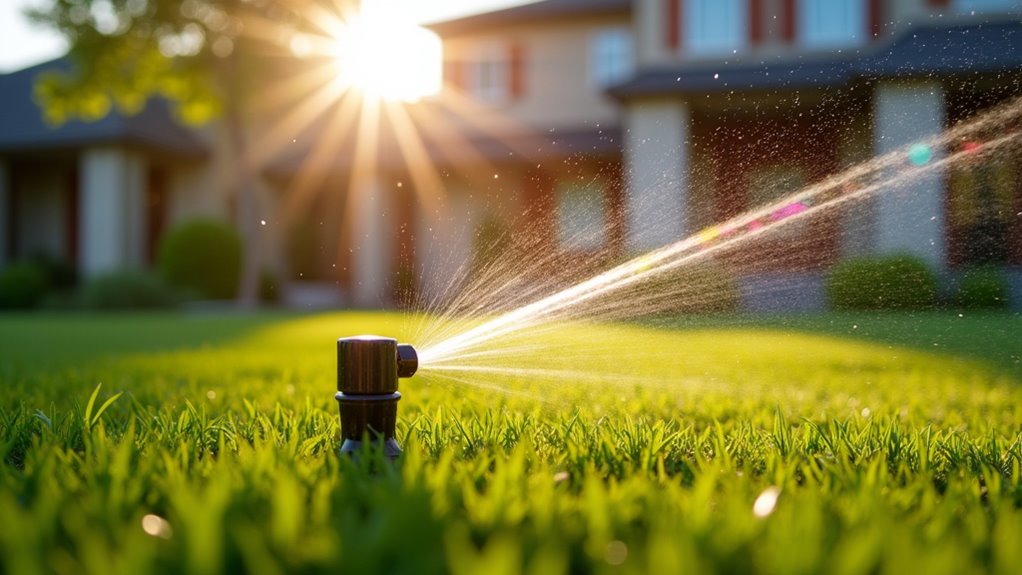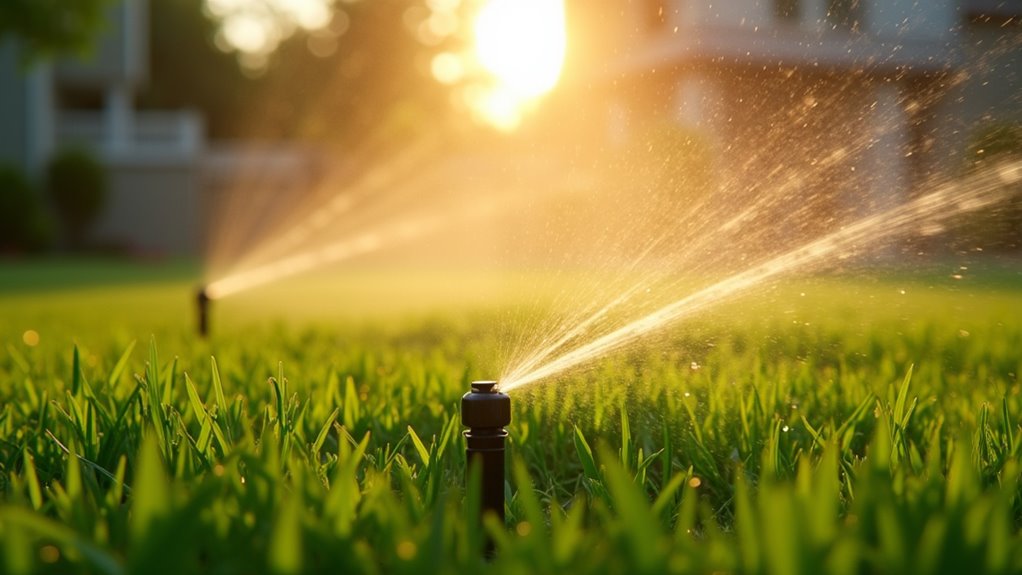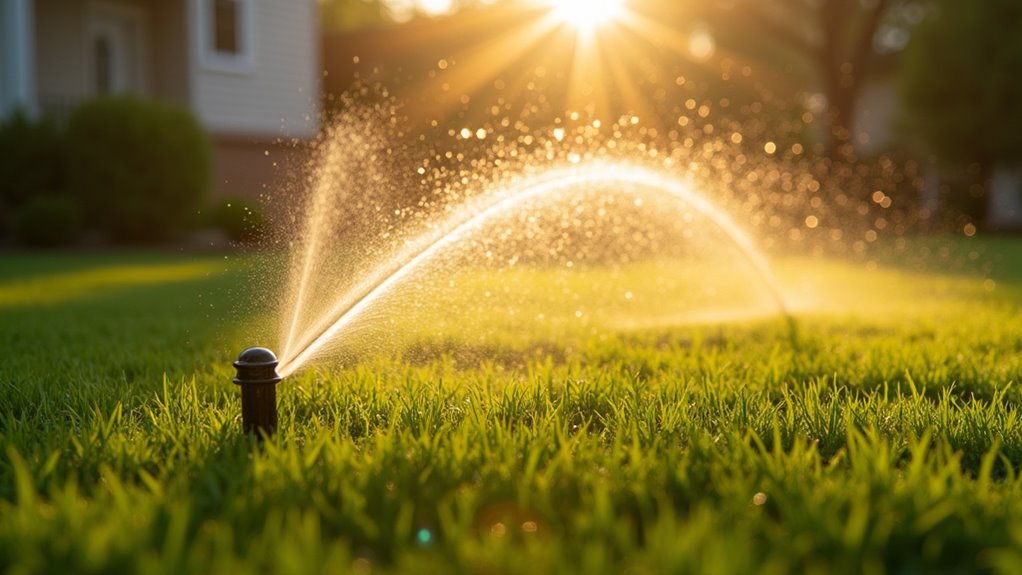Your winter lawn requires precise irrigation of 0.5 inches biweekly when temperatures exceed 40°F. You’ll need to monitor soil moisture using a screwdriver test or moisture meter, and adjust your schedule based on your regional climate patterns. Water during mid-morning hours to enhance absorption and prevent evaporation. For snow-covered areas, you can suspend regular watering as snow provides natural hydration. Understanding your lawn’s specific dormancy signals will optimize your winter maintenance strategy.
Understanding Winter Watering Fundamentals
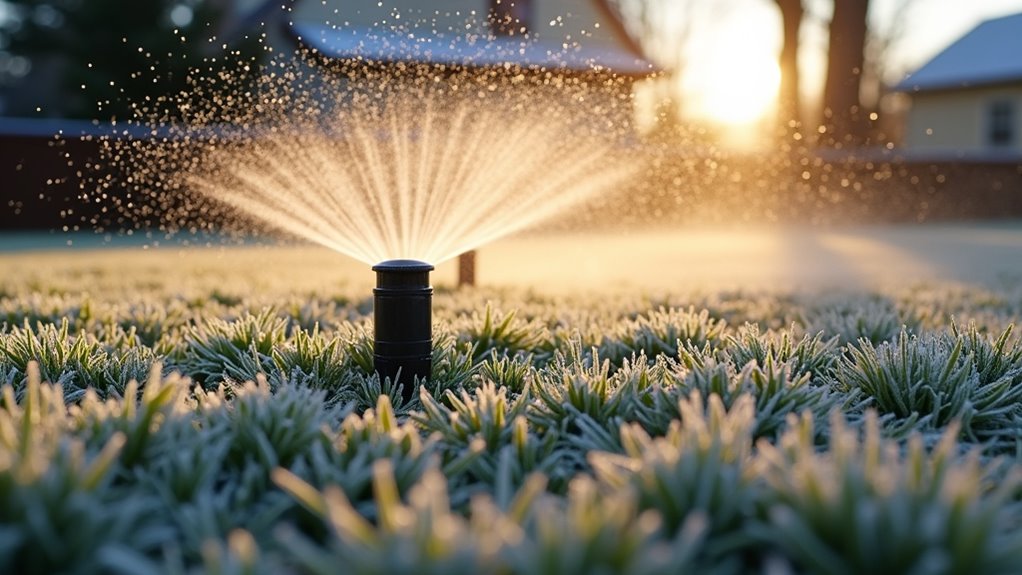
The fundamentals of winter lawn irrigation require a scientific understanding of grass dormancy patterns and precise moisture management. During dormancy, your lawn needs minimal hydration of approximately 1/2 inch biweekly when precipitation is absent. You’ll need to monitor soil moisture levels systematically using either a screwdriver insertion test or a calibrated moisture meter to determine irrigation necessity.
To reduce evaporation and promote ideal root development, you should water sparingly during midmorning hours. This scientific approach prevents moisture-related complications like fungal proliferation and soil compaction that can occur with excessive irrigation. Both cool-season and warm-season grass varieties maintain minimal hydration requirements during dormancy, only necessitating supplemental water during extended drought periods. Recall that insufficient winter moisture can compromise lawn vitality, while overwatering poses equally significant risks to root health.
Temperature Guidelines for Winter Lawn Care
When monitoring winter lawn irrigation, maintaining precise temperature awareness becomes essential for preventing freeze damage and optimizing water absorption. During Winter Watering, you’ll need to carefully track ambient temperatures to protect your turf’s health.
The best time to water your lawn is during mid-day periods when temperatures exceed 40 degrees Fahrenheit, guaranteeing optimal moisture absorption by the root system. You should avoid watering when temperatures drop below this threshold, as freezing conditions can damage grass tissue and impede water uptake.
To maximize your lawn’s winter resilience, secure adequate hydration before freezing weather arrives. Monitor meteorological forecasts and schedule irrigation accordingly. This methodical approach to temperature-based watering helps maintain proper soil moisture levels while preventing potential freeze damage to your turf grass during critical winter months.
Adapting Your Watering Schedule for Snow Coverage
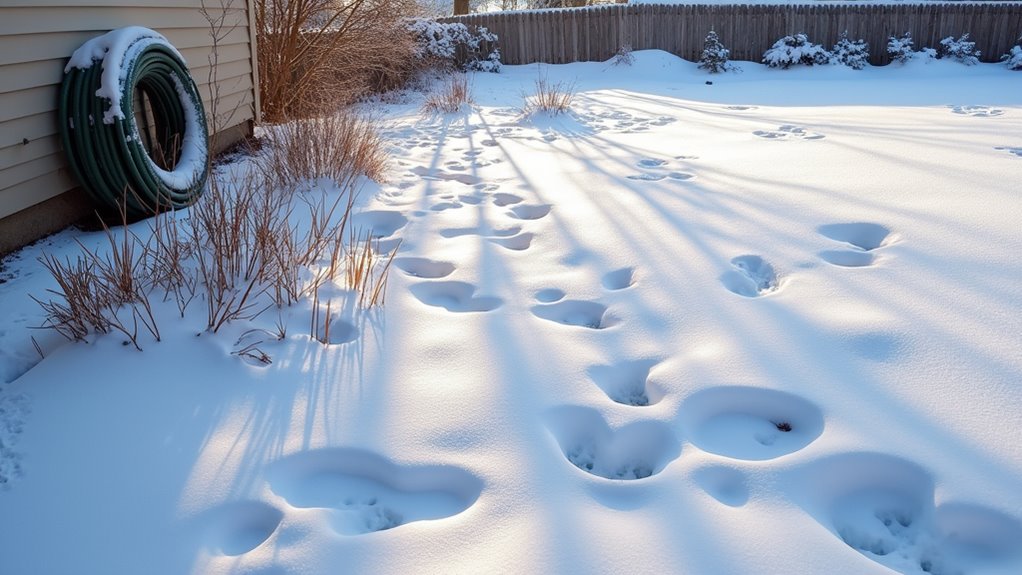
Snow’s natural irrigation properties provide an efficient water source for your winter lawn maintenance protocol. You’ll need to calibrate your supplemental watering schedule by analyzing the snow’s water content and measuring its distribution across your turf surface. When implementing snow as part of your irrigation strategy, monitor areas where drifting or uneven accumulation occurs to guarantee uniform moisture penetration throughout your lawn’s root zone.
Snow As Natural Irrigation
Natural precipitation in the form of accumulated snow serves as an efficient irrigation mechanism for winter lawns, eliminating the need for supplemental watering during periods of consistent snow coverage. As snow gradually melts, it provides sustained moisture delivery to your lawn’s root system, functioning as a slow-release hydration method.
You’ll benefit from monitoring snow accumulation patterns to optimize your winter lawn care strategy. When your terrain maintains adequate snow coverage, you can substantially reduce or eliminate manual watering requirements. This natural irrigation process enables moisture to penetrate deeply into the soil profile, meeting your winter lawn’s hydration needs efficiently. By leveraging snowfall as your primary moisture source, you’re implementing a water-conservative approach while ensuring your lawn receives sufficient hydration throughout the winter months.
Making Snow Work Effectively
To optimize snow’s irrigation potential, you’ll need to strategically adjust your watering schedule based on precise snowfall measurements and coverage patterns. Calculate your lawn’s moisture needs by monitoring snow depth and density using a soil moisture meter at distinct/different/numerous points across your property.
When snow accumulates, suspend your regular watering schedule but maintain vigilance over soil conditions. One inch of snow typically equals 0.10 inches of water, so you’ll need to factor this into your proper watering calculations. If snow distribution is uneven, supplement water in bare patches to prevent dry spots.
In wet conditions, avoid compacting snow-covered areas, as this can create ice layers that inhibit proper water absorption. Instead, allow natural melting to gradually hydrate your soil, adjusting supplemental irrigation only when necessary.
Essential Winter Grass Care by Region
Different geographic regions across the United States demand distinct winter lawn irrigation protocols based on climate patterns and grass species. Lawn care experts recommend adjusting your irrigation system based on your specific location and grass type for best late-winter results.
- Northern regions with cool-season grasses require bi-weekly to monthly light watering during drought conditions to prevent winter desiccation
- Southern states can typically suspend irrigation for warm-season dormant grasses, except during prolonged dry spells
- Pacific Northwest lawns thrive on natural precipitation, while Southwest grass needs monthly deep soaking
For coastal zones, maintain weekly light irrigation to support active growth patterns. Monitor soil moisture levels and local weather forecasts to optimize your watering schedule. This methodical approach to regional-specific irrigation helps preserve root systems and maintains robust spring recovery.
Signs Your Lawn Needs Winter Watering
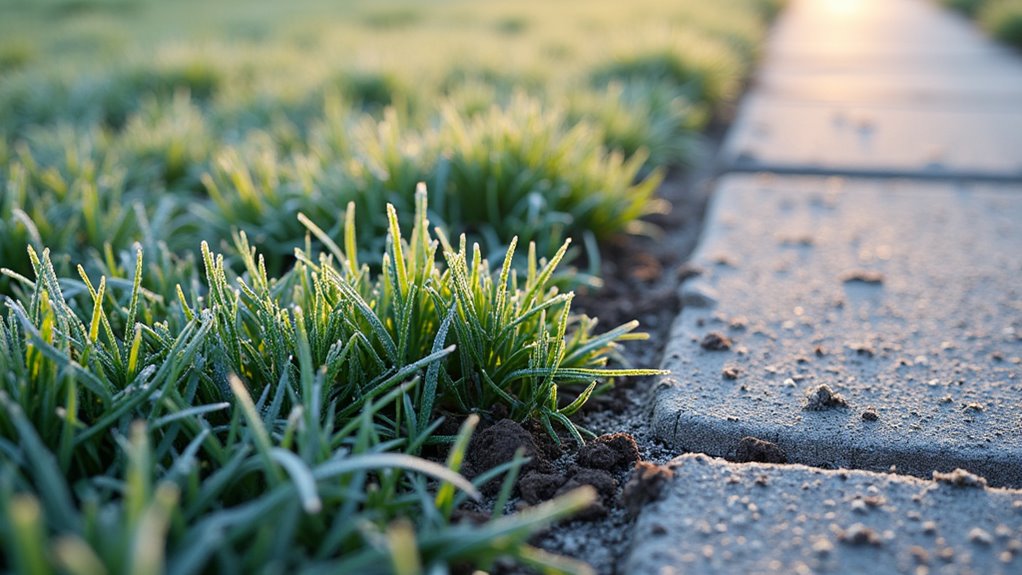
While regional watering protocols provide a foundation for winter lawn care, recognizing specific indicators of water stress enables precise irrigation timing. Your lawn still needs moisture during dormancy, and several visual cues signal when it’s time to water.
Monitor for footprint persistence – if grass blades don’t spring back after being walked on, this indicates diminished turgor pressure. Watch for color changes from vibrant green to blue-gray, which suggests cellular dehydration. Your lawn’s watering needs become evident when blade tips curl inward or when soil pulls away from foundations.
Signs your lawn needs supplemental hydration include visible wilting during midday, even in cool temperatures. Perform the screwdriver test – if you can’t easily insert a screwdriver 6 inches into the soil, you need to water immediately to prevent root damage.
Preventing Common Winter Lawn Damage
To protect your lawn from frost damage, you’ll need to implement strategic pre-frost irrigation, maintaining soil moisture at 40-60% capacity to create a thermal buffer zone around root systems. You can prevent winter root damage by applying a 2-inch layer of organic mulch and maintaining consistent soil temperatures through regulated morning watering schedules between 6 AM and 10 AM. Monitoring soil temperature with a digital probe thermometer will help you identify when protective measures like frost blankets become necessary, particularly when readings drop below 35°F (1.7°C).
Frost Protection Strategies
Protecting your lawn from frost damage requires a systematic approach based on temperature monitoring and precise moisture management. During late fall, make sure to properly time your watering schedule when temperatures exceed 40°F to help your lawn absorb moisture effectively without risking ice formation.
Key protective measures include:
- Implement morning watering schedules to ideal moisture absorption before potential freezing temperatures occur
- Apply insulating mulch strategically around root zones to prevent frost heaving and compact the soil
- Utilize anti-desiccant treatments on evergreen vegetation to minimize winter dehydration
Monitor soil moisture content by checking several inches below the surface before watering. This scientific approach helps prevent oversaturation while maintaining adequate hydration levels. By following these methodical frost protection protocols, you’ll create prime conditions for your lawn’s winter survival and spring recovery.
Avoiding Winter Root Damage
Since winter poses unique challenges for root systems, maintaining ideal moisture balance becomes critical for preventing long-term lawn damage. You’ll need to carefully monitor soil hydration levels to prevent both oversaturation and desiccation, as too much water can trigger root rot and fungal proliferation in frozen soil conditions.
Always check soil moisture levels by inserting a screwdriver or using a moisture meter several inches deep. This testing is needed to ascertain you’re not overcompensating or underwatering your turf. To keep your lawn protected, water only during mid-morning to early afternoon when temperatures exceed 40°F, preventing overnight freezing of surface water. This timing allows proper absorption while minimizing the risk of creating ice formations that could damage root structures. Integrate this watering strategy with proper aeration and overseeding for optimal root health throughout winter.
Smart Irrigation Strategies for Cold Weather
When winter temperatures drop, implementing precise irrigation protocols becomes essential for maintaining lawn health during dormancy. The rule of thumb for watering your lawn during cold months requires strategic timing and precise measurement to guarantee enough water without risking damage.
Key winter irrigation protocols:
- Monitor soil moisture levels consistently and apply 1/2 inch of water only when precipitation has been absent for 30+ days
- Schedule irrigation during mid-morning hours when temperatures exceed 40°F to prevent overnight freezing damage
- Maintain a 2-4 week watering interval to prevent both root desiccation and oversaturation
To water my lawn effectively during winter, utilize soil moisture sensors and weather monitoring systems to optimize irrigation timing. This methodical approach prevents common winter turf issues like fungal proliferation and root system deterioration while securing adequate hydration for spring recovery.
Professional Tips for Winter Lawn Maintenance
Professional lawn care experts offer scientifically-backed recommendations that build upon standard winter irrigation practices. They emphasize monitoring soil hydration levels using penetration tests or moisture meters to determine if your lawn needs to be watered. It’s a good idea to consult these specialists when calibrating your irrigation system for winter dormancy periods.
Experts recommend adjusting your sprinkler system to deliver precisely 1/2 inch of water biweekly when temperatures exceed 40°F, typically during mid-morning hours. They’ll assess your soil composition and drainage patterns to prevent oversaturation, which can trigger pathogenic fungal growth and root deterioration. Through systematic moisture management and professional oversight, you’ll maintain ideal soil hydration while avoiding common winter irrigation pitfalls like soil compaction and root rot. This scientific approach guarantees your lawn receives adequate hydration without risking damage from overwatering.
Preparing Your Lawn for Spring Success
To establish ideal spring growth conditions, implementing a systematic fall preparation protocol substantially impacts your lawn’s post-dormancy recovery. The precise timing of fall maintenance allows the soil to maximally prepare for spring and summer regeneration cycles.
- Aerate compacted areas and overseed bare patches when it’s best to water, ensuring 2-3 inch grass height to optimize nutrient retention
- Remove accumulated organic debris that could impede water absorption when you water the lawn during winter dormancy
- Apply targeted pre-emergent weed control combined with balanced fertilization to strengthen root systems
These methodical interventions create an environment that allows the soil to maintain essential moisture levels while preventing common winter stressors. By addressing potential impediments to growth during fall preparation, you’re establishing prime conditions for vigorous spring emergence and sustained summer vitality.
Frequently Asked Questions
How Often Should a Lawn Be Watered in Winter?
You’ll need to water your lawn just once per week during winter to maintain ideal moisture levels while practicing water conservation strategies. You should implement seasonal watering adjustments by irrigating during mid-morning when temperatures exceed 40°F. Monitor soil conditions and consider alternative irrigation methods like drip systems for precise control. You’ll want to apply approximately 1/2 inch of water, adjusting frequency based on your grass type and local drought conditions.
Is 10 Minutes Long Enough to Water Grass?
No, 10 minutes isn’t long enough for suitable lawn hydration. The ideal watering duration should be 15-45 minutes per zone to confirm proper root penetration. You’ll need to adjust your sprinkler system maintenance and timing based on your specific soil composition and grass type. Using soil moisture monitoring tools, like a moisture meter or screwdriver test, can help you determine when you’ve reached adequate depth. Implement water conservation strategies by watering deeply but less frequently.
How Long Can Grass Go Without Watering?
During the dormant season, your grass can typically survive 3-4 weeks without watering. You’ll find that when frozen ground implications come into play, your lawn’s water requirements decrease markedly. Snow cover effects provide natural moisture, reducing the need for supplemental watering. Your lawn’s seasonal growth patterns also impact its water needs – dormant grass can actually survive up to 6-8 weeks without water, though extended drought periods may compromise turf health.

